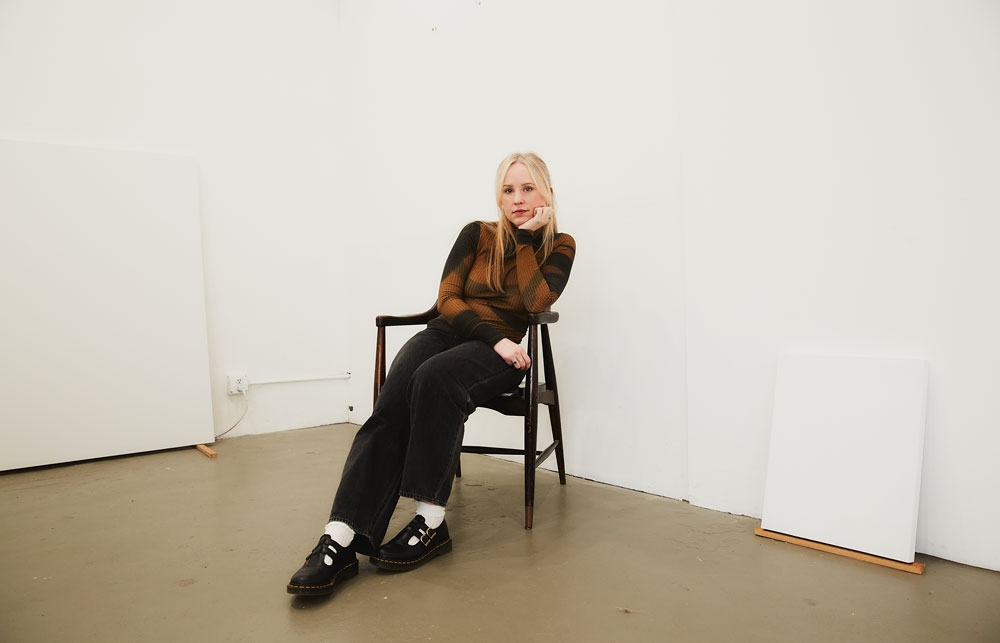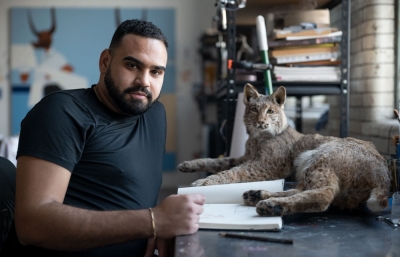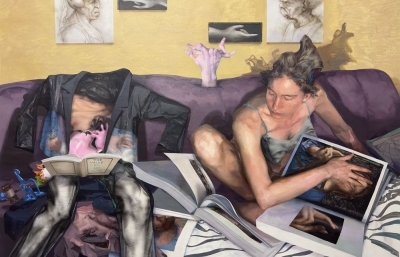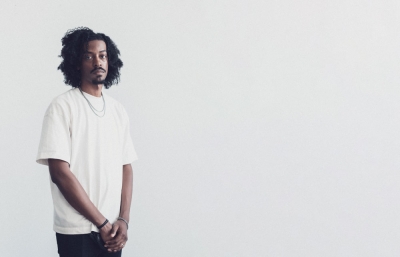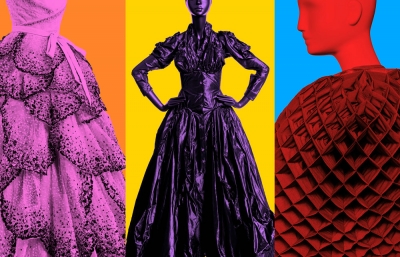Maud Madsen
Formative Moments
Interview by Kristin Farr // Portrait by Morganne Boulden
Maud Madsen plunged headfirst into a welcoming art world, fairly fresh from her MFA program, with incomparable paintings oscillating between tension and leisure, confusion and calm. Our conversation reveals a deeply technical practice fortified by the artist’s studies in anatomy, a combination resulting in perspectives that feel previously unexplored—Maud Madsen is wading into a new frontier of figurative painting. She renders light, emotion, atmosphere, and personal experience as amalgamations that feel universally resonant but also ripe with the possibility of wildly varying interpretations.

Kristin Farr: How did your family end up moving to Pennsylvania from Canada, and which parts of your childhood show up most in your paintings?
Maud Madsen: I was four when my family moved to Pennsylvania, when my dad got a job in New York City. I come from a big family. I'm one of five kids, so it was more affordable for us to live in a nearby state and for my dad to commute.
My parents bought a 200-year-old farmhouse with a barn in Bucks County, and we lived there for 7 years before moving back to Canada. Almost all of my imagery comes from that time in my life. My siblings and I spent nearly all of our time outside barefoot. There was a creek running along the front edge of the yard where we waded and looked for crawdads and water striders; a long driveway that I remember as endless, which we would cover in chalk drawings; and a backyard swing set that we would jump around on while pretending the ground was lava. It was isolated because we were in a pretty rural area, but sometimes that was a good thing. I remember it as an adult-free paradise where it never felt like anyone was watching.
Many of the memories in these paintings relate to the moment a girl becomes aware of her body as something that others will use to evaluate her worth—the age when you are suddenly aware of being watched, assessed, and measured up to a standard. I think, as an adolescent, that awareness didn't always carry the same fears and anxieties: I remember that, for me, sometimes the attention felt like an approval or recognition of what I saw as maturity, a signal of approaching womanhood, something that I craved without understanding the full implications. I think about that parroting of adult behaviors a lot.
Tell me also about living in Canada and how you remain connected to the Canadian artist community.
At the end of my time in elementary school, we moved back to Canada. I remember it as a potential departure from childhood because, starting in sixth grade, I would be in middle school and on my way to adulthood. But when we arrived, I learned junior high began in grade seven in Canada, so I still had a year remaining in elementary.
Living in Edmonton was wildly different from living in Pennsylvania. Our new house was just inside the city limits, but we took a bus to our school. We switched from the public school system in the States to the Catholic school system in Canada. There were a lot of growing pains in adapting to all of those changes, especially at an age where you're suddenly hyper-aware of your growing body and the pressures that come with that.
After high school, I completed my Bachelor of Fine Arts at the University of Alberta. The program was great, but I was a little lost artistically and struggled to find a cohesive center for my practice. After graduation, I didn't make any art for two years. I worked full-time while paying for a shared studio space I never used. When I finally felt ready to return to the studio, I realized I didn't have the technical skills to create the work I wanted. I decided to go back to school and ended up at the New York Academy of Art in 2018 for my MFA in painting. While I have yet to exhibit in Canada, I keep in touch with the community I joined through university. I even taught an online course with them while living in Brooklyn during the first year of the pandemic, which was a really valuable experience.
There's also a great community of Canadian ex-pat artists in New York City who support each other. They've even created an award to recognize ex-pat women artists, and I was lucky enough to be a recipient of the Canadian Women Artist's Award from the New York Foundation for the Arts.

How do you describe Chicken Skin, an early figure from your paintings?
When I first started painting this series, I was focused on exploring the spaces of my childhood, specifically the places we built and constructed as a means of escape. I thought a lot about safety versus danger and security versus instability. So I started to paint imagery of places that represented entire worlds to me as a child but were temporary and fragile: forts constructed of pillows and blankets and castles made of sand. When it felt like these environments needed an inhabitant, I wanted to create a character who needed them.
At first, she was a self-caricature, laying bare the inner battles and insecurities that began in adolescence that still haunt me. With time, she has developed into someone who can be a vehicle for me to talk about things I am processing. She can revisit spaces and relationships that no longer exist. She can sometimes be me, and she can sometimes be her. I nicknamed her Chicken Skin after the keratosis pilaris that covered my arms and legs as a child and still freckles me to this day. So she is me, and at the same time, not me.
Your figures seem both adult and adolescent at the same time. Are there specific experiences you’ve had in that realm that inform the work?
I like to think of them as adults inhabiting spaces they have outgrown. When I reflect on my childhood's formative places and experiences, it's impossible to separate my adult self from my recollections, so it felt natural to populate my paintings with adult bodies.
As an example, when I was in grade seven or eight, my friends and I would dress up in outfits and put on makeup to take walks to the nearest 7-Eleven for five-cent candies, judging how "successful" our walks were by the number of catcalls we received from grown men in their cars as they drove past. We were too young to realize what they meant by their words and didn't recognize that it was a form of harassment. That memory was one of the first moments I explored in the painting Need a Ride?

Since your paintings are of women and girls interacting, I wondered if you reference your own sisters in the paintings.
Yes, definitely! I have three sisters, and we grew up very close. In fact, most of the clothing in my paintings references items that I wore, or my sisters, or all of us as hand-me-downs. Additionally, while they aren’t featured explicitly, much of the imagery is inspired by conversations we’ve had about shared memories or activities. I have plans for some future paintings that may begin to feature them more specifically.
The artist Hung Liu would say “memory is slippery,” which I remembered when looking at your work. How do you think about memory or nostalgia in relation to your work?
All of my paintings are reconstructions of memories. I don’t believe them to be accurate retellings, as I often conflate memories from different times and places. I find it impossible to separate my adult self—with my trauma, anxieties, and insecurities—from my recollections. I know there was a time when I was free from this feeling of performativity, but I can’t seem to remember it. I struggle with the word nostalgia. To me, it evokes a desire for the past, to return to another time, and I don’t want that. I want to be here and now. I would rather be informed by the past but dwell in the present.
I think it’s interesting how memory plays a role in personal myth-making, and I am interested in how people, including myself, edit or omit embarrassing details from stories to keep the conversation light and project a more ideal version of ourselves. Or how, in a group dynamic, a memory may morph or change as people debate the “true” retelling of an event. In my experience, in the search for an “objective” truth, many details are lost or sometimes purposely erased to see the event through rose-colored glasses or from a particular perspective.
I’m also fascinated by the general tendency for individuals to rely upon memories, which are flexible, corruptible, and unreliable, as the basis for their senses of self, as if those memories were concrete, factual narratives.

"I’m also fascinated by the general tendency for individuals to rely upon memories, which are flexible, corruptible, and unreliable..."
Your work seems to have evolved and solidified stylistically in the last 3 years; have you noticed the change, and was school a part of the shift?
I’ve definitely noticed a shift in my practice. My work really began to change at the tail end of my MFA, and while, at the time, it felt like a breakthrough, looking back, there were many small changes here and there that culminated in the work I’m making now. I would definitely credit school with part of it. During my studies, I was exposed to many artists I wouldn’t have found on my own, and I was constantly being asked to explain my choices and practice, which made me more aware of and intentional with my choices in the studio.
Did your work also change in certain ways when you moved to New York?
Oh, my work has changed so much since I moved here! I had always been interested in making art about the body, but I had always used images of someone else. Going to school in Tribeca, with the proximity of the art world, hugely influenced my development as an artist. There were always openings, shows, and artist talks to see. About halfway through the second year of my program, my school hosted an artist talk with Robin F. Williams that really had an impact on me.
I felt this urgency to run back to my studio and explore my own gendered experience as a woman who was subject to a barrage of conflicting expectations around sexual agency and bodily autonomy. Returning to imagery from my upbringing felt important, as that was when these ideas most likely began to take root.

How did you start perfecting the way you render perspective with the figure? Are you working from source images?
Many of the skills I use daily are from things I learned in graduate school. I did an anatomy specialization, where, besides life drawing, I also took classes such as human anatomy, écorché, animal anatomy, and dissection, where we studied and drew from human cadavers. Between that and my other coursework, I learned a great deal about rendering the form and creating convincing foreshortening and perspective. I say convincing because my paintings aren’t usually anatomically correct, because sometimes a gesture just works better with some distortion or exaggeration.
To make my paintings, I produce a ton of compositional sketches to sort the perspective and pose, and then in the final drawing I’ll introduce source imagery where I need more detail than my imagination can conjure, such as with the texture of asphalt, the pattern on a shirt, or the shape of a hand.
Is it true you sometimes make miniature models for your paintings?
I hesitate to call them models; they are poorly constructed and generally made of just cardboard scraps and glue. I use them occasionally when I'm struggling to sort a shadow shape or draw an environmental structure in perspective. I used one in the painting Groundless. I wanted to reference the roofed playhouse structure at the top of the slide attached to most backyard swing sets, but I couldn't figure out how to draw it from such a low, foreshortened angle. The little model was just a few strips of cardboard, but when viewed from the right angle, it was all the information I needed to invent the rest in wood and metal.
More recently, I've gotten into the habit of buying and accumulating props to draw from in real life. As an example, the swim goggles in Guppy are modeled off of a pair I picked up from Target.
How does your approach to color and limited color palettes help you convey a mood or atmosphere?
Whenever I imagine a painting, I try to think about how everything felt. Was the air hot and sticky? Did the asphalt burn the soles of my feet? Was the pool water refreshing or tepid? Once I get the feel of the memory, a color usually seems to fit, like how Payne’s grey and a little bit of white make this subtle cold blue that feels like the middle of a moonless night.
I use the color that emerges from that thought exercise as a starting point for the rest of the palette so that it permeates every detail of the piece, infusing it with a particular mood or feeling. As the process is very intuitive, it involves a lot of trial and error. In the past, I have repainted some passages again and again, and I always seem to end up with something that resembles the first version. Recently, I have begun making color studies as a step between the drawings and the large paintings to be confident that the color world works before I start the bigger piece. It means I can use the time I would have spent repainting to develop my color even further.

How do you approach and study the representation of light? You have a magnificent way of painting light.
Thank you! The light and color are deliberate choices on my part. The preparatory drawings are a crucial step in that process. Once I've determined which one feels most true to me, I'll invest in a larger composition, which helps me synthesize all my thoughts and influences into a singular image. It always begins as a line drawing, and I'll get the entire thing into a tight contour drawing, committing to the objects, textures, and background environment. After getting to a scene I'm happy with, I'll pick a light direction and just start shading it in.
I think it's always kind of magical how the same image can feel entirely different if it's backlit versus sun-drenched. So yeah, I'll mess around with the drawing for an extra day or two, adding shadows and highlights and fleshing out the volume and shapes. I also find light and shadow to be valuable players in storytelling, like how light can obscure or hide the figure instead of illuminating it or how the direction of shadows can imply or suggest an audience beyond the frame.
Do you always make a drawing as a study for the paintings?
Yes, it has become an invaluable step in my process. I have tried once or twice to skip this step or rush the drawing, and it never turns out. I try to take my time with it and investigate the volumes and tonality. When it comes time to paint, I tape the drawing up alongside the canvas, and that becomes my only source image.
The painting only departs from the drawing when the scale of the more extensive work demands more detail or when something that wasn’t a big issue becomes exacerbated in the larger work. For example, I can get away with a shorthand for the expression on a figure’s face in the drawings, whereas the same application feels out of place in a larger painting.

Are there certain figurative painters or other artists you feel connected to, either from now or history?
Yes, I get a lot of influence and inspiration from other artists, especially when it comes to color, composition, and storytelling. To name a few in no particular order, Alex Colville, Joan Semmel, Jeff Wall, Lisa Yuskavage, and Louis Fratino.
What kind of archetypes or tropes do you explore most?
While most of my imagery comes from my memories, I like to reference historical figurative paintings; most recently, I have been exploring the trope of women as muses, nymphs, and bathers.
Do you imagine a soundtrack to your paintings, like music or other sounds?
You know, I’ve never thought about soundtracks for my paintings, but I did listen to a lot of Kate Bush when I first started this series!
What are you working on now and next?
Up until now, all of my paintings have been in acrylic, but I've recently hit a bit of a wall where the direction I want to take the paintings might be better suited to oil painting. Over the last two months, I've started working in oil, so my big project this year is trying to replicate my process in a new medium and see where that takes me. I've already learned that I need to work on my patience for drying times, haha. Besides that, I have a couple projects in the works this year, including a spotlight feature at Flag Art Foundation.
*
MaudMadsen.com // This interview was originally published in our SPRING 2024 Quarterly

